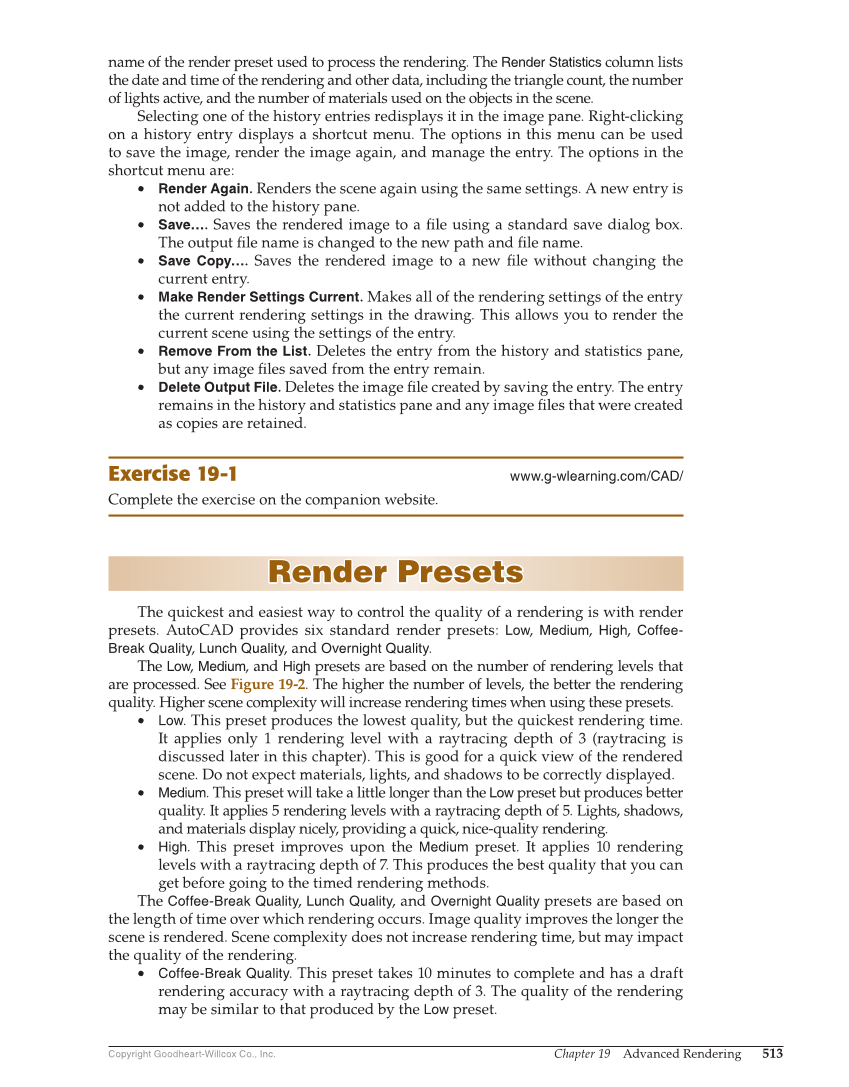Chapter 19 Advanced Rendering 513 Copyright Goodheart-Willcox Co., Inc. name of the render preset used to process the rendering. The Render Statistics column lists the date and time of the rendering and other data, including the triangle count, the number of lights active, and the number of materials used on the objects in the scene. Selecting one of the history entries redisplays it in the image pane. Right-clicking on a history entry displays a shortcut menu. The options in this menu can be used to save the image, render the image again, and manage the entry. The options in the shortcut menu are: • Render Again. Renders the scene again using the same settings. A new entry is not added to the history pane. • Save…. Saves the rendered image to a fi le using a standard save dialog box. The output fi le name is changed to the new path and fi le name. • Save Copy…. Saves the rendered image to a new fi le without changing the current entry. • Make Render Settings Current. Makes all of the rendering settings of the entry the current rendering settings in the drawing. This allows you to render the current scene using the settings of the entry. • Remove From the List. Deletes the entry from the history and statistics pane, but any image fi les saved from the entry remain. • Delete Output File. Deletes the image fi le created by saving the entry. The entry remains in the history and statistics pane and any image fi les that were created as copies are retained. Exercise 19-1 www.g-wlearning.com/CAD/ Complete the exercise on the companion website. Render Presets Render Presets The quickest and easiest way to control the quality of a rendering is with render presets. AutoCAD provides six standard render presets: Low, Medium, High, Coffee- Break Quality, Lunch Quality, and Overnight Quality. The Low, Medium, and High presets are based on the number of rendering levels that are processed. See Figure 19-2. The higher the number of levels, the better the rendering quality. Higher scene complexity will increase rendering times when using these presets. • Low. This preset produces the lowest quality, but the quickest rendering time. It applies only 1 rendering level with a raytracing depth of 3 (raytracing is discussed later in this chapter). This is good for a quick view of the rendered scene. Do not expect materials, lights, and shadows to be correctly displayed. • Medium. This preset will take a little longer than the Low preset but produces better quality. It applies 5 rendering levels with a raytracing depth of 5. Lights, shadows, and materials display nicely, providing a quick, nice-quality rendering. • High. This preset improves upon the Medium preset. It applies 10 rendering levels with a raytracing depth of 7. This produces the best quality that you can get before going to the timed rendering methods. The Coffee-Break Quality, Lunch Quality, and Overnight Quality presets are based on the length of time over which rendering occurs. Image quality improves the longer the scene is rendered. Scene complexity does not increase rendering time, but may impact the quality of the rendering. • Coffee-Break Quality. This preset takes 10 minutes to complete and has a draft rendering accuracy with a raytracing depth of 3. The quality of the rendering may be similar to that produced by the Low preset.
